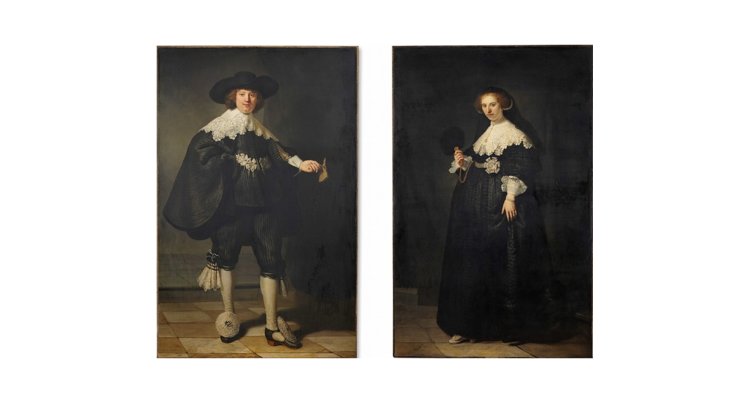Maerten Soolmans, a rich merchant of the Dutch Golden Age, married Oopjen Coppit in 1633. On this occasion, he ordered portraits of him and his new wife to a particularly popular portraitist of Amsterdam: Rembrandt van Rijn. Who would have known, then, that four centuries later it would become the basis for a new type of cooperation between France and the Netherlands?
The two portraits, showing each character in full-length, are a brilliant example of the Dutch artist’s ability to render a lively and deep presentation of his subjects, making a personal use of chiaroscuro to emphasise the internal world of his contemporaries.
However, the two portraits remaining in private collections, the public barely had the occasion to enjoy the view of such a piece of art during the past four centuries. Part of the Rothschild family’s heritage since 1877, they were exhibited only once in 1956 at the occasion of a common exhibition by Amsterdam’s Rijksmuseum and Rotterdam’s Museum Boijmans Van Beuningen. In spring 2013, the Rothschild family contacted the Louvre to sell the portraits for €160 million. This price, considered as being well too high by several experts, was discussed for a year, until the Louvre gave up, advancing the lack of financial means to acquire the paintings. The portraits got then the authorisation to be exported, giving rise to a controversy [1] about the status of “national treasure” which they deserve, and which would have protected them from the risk of being sent away from European soil.
A Dutch-French solution
In this French problem, another country had particular interests in keeping the paintings here: the Netherlands, where Rembrandt is, deservedly, a national pride. More prompt than France to see the portraits back on its national territory, the Dutch government, represented by the culture minister Jet Bussemaker, said on the 25th of September that it was ready to pay half of the €160 million, and let the Rijksmuseum gather the remaining €80 million. But in the meanwhile, the presidents of the Louvre and the Rijks had already advanced the idea of a common solution, and French minister Fleur Pellerin had submitted the offer to jointly acquire the inseparable couple, each museum buying one of the two paintings.
This novel solution was finally adopted on September 30th, after the Dutch Prime Minister Mark Rutte and the French President François Hollande discussed the matter on a meeting in New York. Jet Bussemaker and Fleur Pellerin announced the deal on a joint statement: “Both ministers have been working closely for several months to secure this agreement, through which the two paintings will be exhibited together, alternatively in the Rijksmuseum and the Louvre. The owners of the works have confirmed their agreement for this joint acquisition.” [2]
Not only are the paintings staying on European soil, when concerns had been expressed about seeing them sold to bolder purchasers like the US or Qatar, but they will also be exhibited in two of the most prestigious museums of the world, and visible by the publics of both countries.
Museums and the EU: non-state actors bringing up European construction
However these are not the only positive consequences of the deal. Far beyond musealistic considerations, such an agreement can be seen as an original way of deepening cooperation between two European countries: “The joint acquisition of these priceless treasures will strengthen the partnership between the Rijksmuseum and the Louvre and exemplifies the shared intention of the two countries to reinforce the deep cultural ties between the two countries” [3] the French ministry declared.
Cooperation between museums to acquire artefacts and masterpieces is not something new, but it is the first time two museums from different countries have cooperated in such a way. As the director of the Rijksmuseum, Wim Pijbes, told Dutch Radio 1, this is “a new concept in the museum world for two countries to work together to obtain works from a private collection.” [4] This reinforces the tendency observed over the past few years, in which museums are more and more prompted to play a significant role in international relations which outstrips their primary functions of conservation, research, education and mediation [5]. This phenomenon has been worrying specialists and professionals of cultural management, who are concerned with seeing museums used as a diplomatic tool by States, sometimes in opposition to their own interests and the needs of the preservation of cultural heritage.
However, the internationalisation of museums is most of the time a positive movement propelled by museums themselves, who multiply exchanges of artworks and specialists, and joint programmes of research. They thus become a non-state actor of public diplomacy, which, in the particular case of the European construction, could highly serve the deepening of non-institutional links between member countries. The joint acquisition of the two Rembrandt by the Rijksmuseum and the Louvre seems to be both an achievement in the strengthening of cultural ties between two European countries, and an opening towards new perspectives of European cooperation which would not be political or economic.

Follow the comments: |
|
